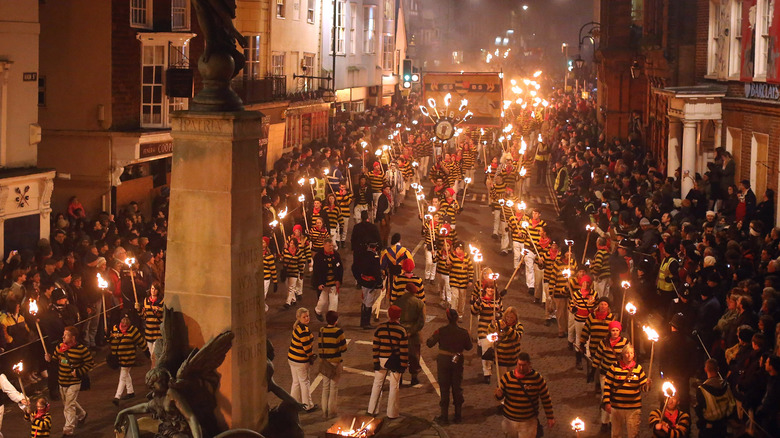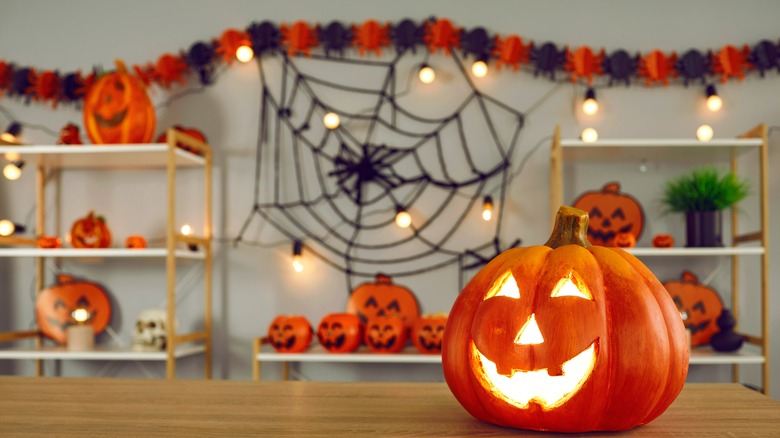The Real Reason These Colors Are Associated With Halloween
Specific traditions are closely associated with many holidays. When thinking of Halloween there are a few things that immediately come to mind, like costumes, jack-o'-lanterns, trick-or-treating, and haunted houses. The connection is clear; Halloween is when you are most likely to see all of those things. Another notable aspect of Halloween is the season's predominant color scheme: orange and black.
When October rolls around, orange and black are everywhere. The two colors dominate decorations. Store aisles are littered with a variety of choices, but nearly all are in orange and black. It has become a staple of Halloween. To understand why orange and black are the two colors most associated with Halloween you have to go 2,000 years into the past, to when the holiday began. According to History, the origins of Halloween can be dated back to the Celtic festival of Samhain, an event that signaled the end of the harvest season and the beginning of winter.
A centuries-old tradition
The Celts celebrated their new year on November 1, the day that meant winter was beginning. The also believed that on the eve of the New Year the ghosts of the dead were able to return to earth, since the boundary between the world of the living and the world of the dead was blurred (via History). So, traditionally during the festival of Samhain, in an effort to ward off the ghosts, people would don costumes, light bonfires, and give sacrifices to their gods (via History).
The Celts were eventually conquered by the Roman Empire. As the Celtic society became intermingled with the Roman society, so too did the tradition of Samhain. According to History, Samhain was first combined with two Roman festivals: Feralia, and a day in honor of Pomona, a Roman Goddess. Later on, after the collapse of the Roman Empire, the Catholic Church also adapted the Samhain traditions for their own holidays on November 1 (All Saints' Day) and November 2 (All Souls' Day) (via History). The night before these holidays, October 31, would come to be known as All Hallows' Eve. As the Christian church spread to the Americas, All Hallows' Eve spread with it, and over time it has morphed into the Halloween we all know. The Halloween we celebrate today may not look much like the ancient Celtic festival of Samhain, but the symbolism of the colors orange and black continue.
Orange and black
The color black has long been associated with death. Many depictions of death, such as the grim reaper, are commonly dressed or shrouded in black. Since Samhain was closely related to human death and the world of the dead, the color black was very significant to the festival (via Reader's Digest). The original meaning of black had more to do with sadness than being scary or eerie, as is usually associated with Halloween today.
According to Reader's Digest, there are a couple of meanings behind the color orange's association with Halloween. The first is that Samhain used to represent the changing of seasons. After the summer, with trees lush with green, the winter was coming and the trees now were covered in orange leaves ready to fall. The second reason for the use of the color orange stems from another staple of the Samhain festival: fire (via Reader's Digest). Fire was a main aspect of Samhain. Traditionally a sacred bonfire would be built and then members of the community would relight their own hearths from that bonfire (via History).
Today most people think of Halloween as a day to dress up and, if you're a kid, collect as much candy as you can. And while that is how we celebrate it now, many aspects of Halloween continue to bear the influence of previous iterations of the holiday.


